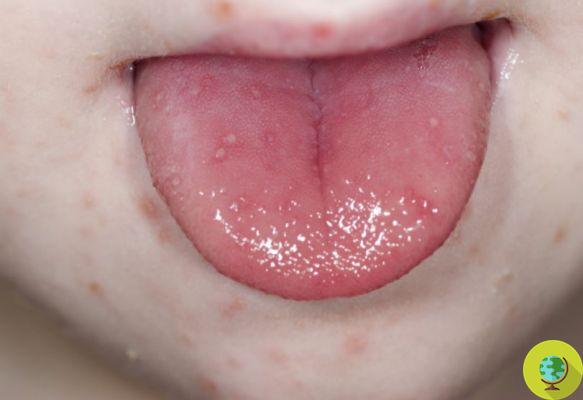Everything you need to know about mouth and feet disease, a very common and highly contagious infection among babies and children: incubation time, how to recognize it and how to treat it
Don't store avocado like this: it's dangerousMouth hands feet: many parents have heard of it or know it firsthand as it is one exanthematous disease very common, especially in children who attend nurseries and kindergartens. The popular name by which this syndrome is known refers to the fact that the skin rash is especially evident on some specific areas of the body.
It is a disease of a viral nature certainly annoying for children but which does not present particular risks. It spreads particularly in the period of transition from summer to autumn, although obviously it can also be infected in the rest of the year.
Read also: Chickenpox in children: how to recognize it and remedies to relieve itching (photos)
Index
Causes
Hand and foot mouth can be caused by several viruses of the family Enterovirus, in most cases it is an infection due to the coxsackie virus which causes mild symptoms that resolve on their own within about a week. Even if it is not a particularly contagious disease, it is easy for the virus to spread closed and crowded places just as they are kindergartens, schools, sports centers, etc.
It is transmitted basically in two ways: by air through coughing and sneezing but also through contact, directly with the liquids contained in the blisters, with mucus but also by touching the surfaces on which the infected person has rested. On the other hand, contamination through contact with the feces of a patient with mouth and feet is much rarer (in this case, even after a month there is the risk of contagion), it can still happen, for example, to parents or educators who change the diaper or who are struggling with cleaning the potty.
Adults are not exempt from the disease but, in most cases, even if infected, they show no sign of its presence, this suggests that most of the time it is a very mild viral form.
Generally the person is contagious especially in the first days of the disease but one cannot be sure of this since the virus tends to remain in the body even after all the symptoms have disappeared and in the stool for even a month. As for the incubation period this can vary from 3 to 7 days.
The mouth, hands and feet it is a disease that usually does not return once it appears. However, this is not always true, in fact even if specific antibodies are developed it is always possible to come into contact with another species of virus (compared to the one that has already been defeated) that causes it.
Symptoms
The first symptoms of the hand and foot mouth are a not too high fever (usually around 38 °), loss of appetite, pain, sore throat and general malaise. After a couple of days, the rash appears which is characterized by red spots and small pustules located mainly within the mouth (on the tongue, inside the cheeks and gums), on the sides of the mouth but also on the palms and feet. Blisters, especially those in the mouth, tend to rupture spontaneously and can be very annoying to children, especially when they have to drink and eat.

@SCIENCE PHOTO LIBRARY
Le blisters tend to turn gray and are small in size (2-5 mm) and round. Generally the rash does not itch and only in some cases the blisters also appear in other areas of the body, especially the buttocks. Even if they itch, do not scratch as your fingers could help spread the infection further. Other problems such as diarrhea and very high fever are rarely seen.
The course of the disease lasts about a week and it does not present particular risks or contraindications, so much so that often nothing is prescribed, just some antipyretic in case the fever exceeds 38.5 °. The only thing to do caution è that the child can drink normally, as the small ulcers on his mouth could bother him so much that he cannot swallow and swallow anything.
Hand-Mouth-Foot Disease is a viral infection that children can get very easily. Striking ...
Posted by Giancarlo Gasparini on Monday, March 28, 2022
How to recognize the disease
In the initial stage, when only a fever appears, it is easy to confuse this exanthematous disease with a banal flu or with the onset of other syndromes of the same category (sixth disease, chicken pox, etc.).
Read also: SIXTH DISEASE: HOW TO RECOGNIZE IT AND HOW LONG THE INCUBATION LAST
Then when therash made of small blisters, bubbles and redness particularly concentrated around and inside the mouth, the situation becomes clearer. Within two days then we see the exanthematic rash appear also on the hands and feet, at this point the presence of the virus can be considered overt. In case of doubts, however, always contact your family pediatrician who, with his experience, will immediately recognize whether it is mouth, hand, foot or something else.Often then, if the little ones attend kindergartens and schools, it is the other mothers or the educators themselves who warn that there has been some child who has developed mouth, hands, feet and consequently at the first symptoms it is easy to reconnect things.
Follow us on Telegram | Instagram | Facebook | TikTok | Youtube
On diseases affecting children, you may also be interested in:
- Rubella
- Mumps
- Chickenpox in children
- Mouth hands feet
- Scarlet fever
- Sixth disease


























